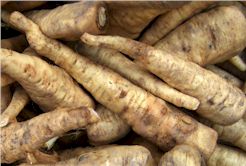|

Garden Parsnip |
The Wild Parsnip (Pastinaca sativa) grows on the borders of ploughed fields and about hedgerows, being generally hairy, whilst the Garden Parsnip is smooth, with taller stems, and leaves of a yellowish-green color. This cultivated Parsnip has been produced as a vegetable since Roman times. The roots furnish a good deal of starch, and are very nutritious for warming and fattening, but when long in the ground they are called in some places "Madnip," and are said to cause
insanity.
Chemically, they contain also albumen, sugar, pectose, dextrin, fat, |
cellulose, mineral matters, and water, but less sugar than turnips or carrots. The volatile oil with which the cultivated root is furnished causes it to disagree with persons of delicate stomach; otherwise it is highly nutritive, and makes a capital supplement to salt fish, in Lent. The seeds of the wild Parsnip (quite a common plant) are aromatic, and are kept by druggists. They have been found curative in ague, and for intermittent fever, by their volatile oil, or by its
essence given as a medicine. But the seeds of the garden Parsnip, which are easier to get, though not nearly so efficacious, are often substituted at the shops. A decoction of the wild root is good for a sluggish liver, and in passive jaundice.
In Gerard's time, Parsnips were known as Mypes. Marmalade made with the roots, and a small quantity of sugar, will improve the appetite, and serve as a restorative to invalids.
From the mashed roots of the wild Parsnip in some parts of Ireland, when boiled with hops, the peasants brew a beer. In Scotland a good dish is prepared from Parsnips and potatoes, cooked and beaten together, with butter. Parsnip wine, when properly concocted, is particularly exhilarating and refreshing.
The Water Parsnip (spelt also in old "Herbals", Pasnep, and Pastnip, and called Sium) is an umbelliferous plant, common by the sides of rivers, lakes, and ditches, with tender leaves which are "a sovereign remedy against gravel in the kidney, and stone in the bladder." It is known also as Apium nodiflorum, from apon, water, and contains "pastinacina," in common with the wild Parsnip. This is a volatile alkaloid which is not poisonous, and is
thought to be almost identical with ammonia. The fresh juice, in doses of one, two, or three tablespoonfuls, twice a day, is of curative effect for scrofulous eruptions on the face, neck, and other parts of children. Dr. Withering tells of a child, aged six years, who was thus cured of an obstinate and otherwise intractable skin disease. The juice may be readily mixed with milk, and does not disagree in any way.
Herb Simples
The Primitive Simplers presented here show the way of life in other generations, it is not suggested or recommended trying them yourself. |
|
Garden
Herbs
Home
History of Herbs
Herb Gardening
Herbs for Beginners
Drying & Preserving Herbs
Indoor Herb Gardening
Herb Garden
Hints & Tips
Herbal
Cooking
Herb Chart
Using Herbs
Culinary Herbs
Herb
Oil and Vinegar
Herb Teas
Herb Candy
Herb Jelly
Herb Simples
Preface
Introduction
Alphabetical Listing

Trade
Recipes Online
Share your Recipes with others!!
|


